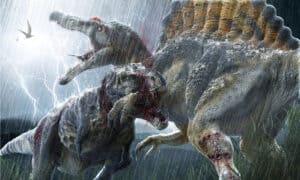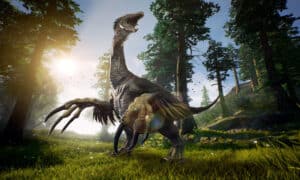Missouri has a complicated geological past. At some points, the land that is now the state was completely underwater. At times, only some parts of the state were submerged while other portions were dry. Fortunately, sedimentation took place during the latter part of the Mesozoic, so scientists have some evidence of dinosaurs that lived in Missouri.
Unfortunately, scientists have only found proof of roughly four different types of dinosaurs even though others probably lived in Missouri. Nevertheless, let’s take a look at the dinosaurs that once roamed this part of the country. First, though, consider the dinosaur that Missourians chose to represent their fine state.

What Is Missouri’s State Dinosaur?
The state dinosaur of Missouri is Parrosaurus missouriensis. This dinosaur was the first one discovered in the state in the year 1942. The large reptile became the state dinosaur in 2004. Yet, that was not before the name of the dinosaur changed a few times.
When scientists first recovered the fossils of Parrosaurus, it was called Neosaurus missouriensis. The scientists that discovered and classified the dinosaur thought it was a sauropod. The dinosaur was eventually identified as a hadrosaur, one of the duck-billed dinosaurs. The dinosaur’s name was changed to Parrosaurus missouriensis.
Yet, in 1979, the name was changed to Hypsibema missouriensis, and that name stuck until 2018 when the name was once again revised to Parrosaurus missouriensis. It’s possible to encounter the former name on documents, but the state website has updated the official state dinosaur to Parrosaurus.
Missouri also has a state fossil called Eperisocrinus missouriensis. This small marine animal lived in the sea that once covered Missouri, and they are sometimes called a sea lily.
Now that you know about one of the dinosaurs that lived in Missouri, let’s get to know the rest.
What Are the 4 Dinosaurs That Lived in Missouri?
Paleontologists have only identified four types of dinosaurs that lived in Missouri. Three of them were identified by their family and one was identified by its species. The geological history of Missouri was not very conducive to preserving dinosaur fossils.
Still, scientists have proof of four different types of dinosaurs that roamed this area, and future studies could yield more fossils and information.
1. Tyrannosaurid
Paleontologists recovered and tried to identify the fossils of a small tyrannosaurid dinosaur found in Missouri. Although the teeth recovered were tentatively identified as Albertosaurus, some researchers doubt the dinosaur belongs to that genus.
Albertosaurus is a genus of dinosaurs that have been found throughout North America, and they were originally discovered in the Alberta province in western Canada.
A true Albertosaurus can grow up to 30 feet long, stand 11 feet tall, and weigh over 5,000 pounds. They were bipedal carnivores similar to Tyrannosaurus rex, but much smaller. Future studies or additional specimens are required to determine the true identity of the tyrannosaurid found in Missouri.
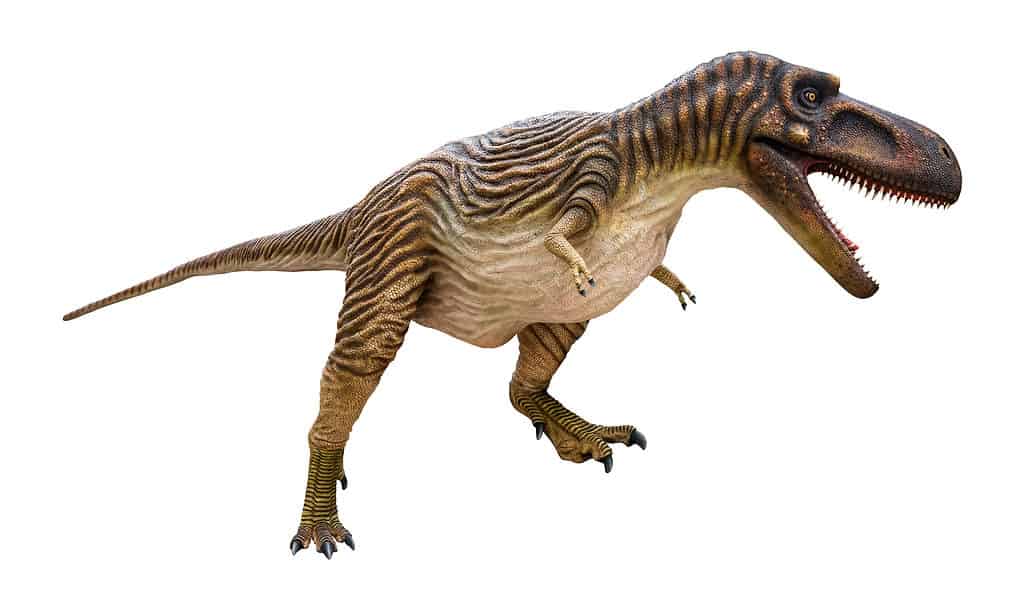
Tyrannosaurid theropod dinosaurs are believed by some to belong to the
Albertosaurusgenus.
©YuRi Photolife/Shutterstock.com
2. Parrosaurus missouriensis
Parrosaurus missouriensis is the state dinosaur of Missouri, and the species has undergone several name changes. The dinosaur is classified as a hadrosaur, a group known for being herbivores with duck-billed snouts.
Scientists estimate that this dinosaur had upwards of 1,000 small, serrated teeth to help it chew its food. The species weighed perhaps 8,000 pounds, measured up to 30 feet long, and stood about 10 feet tall.
The fossils of this creature were found near Glen Allen, Missouri in 1942. The bones of this species were the first ones ever found in the state, but they would not be the last dinosaur discovery made in the area. The bones were found while a property owner was digging a well. The specimens consisted of thirteen vertebrae and two other bones that were gifted away to another person. Future digs at the same site produced teeth and jaw fragments of Parrosaurus.
The site where the Parrosaurus discovery occurred also yielded the aforementioned tyrannosaurid fossils and the next one on our list.
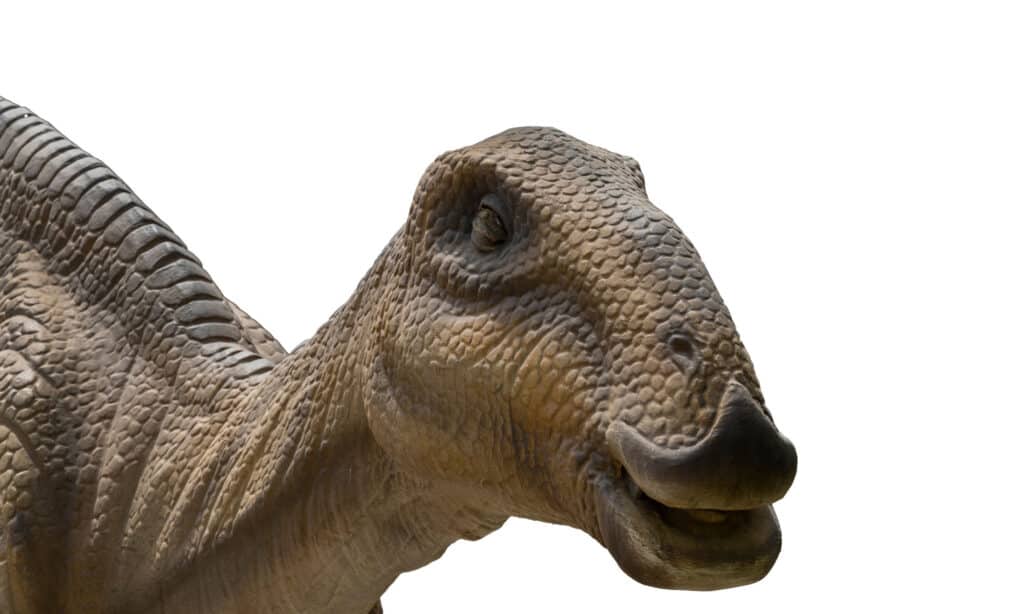
is classified as a hadrosaur, a herbivorous dinosaur known for its duck-billed snout.
©Noiel/Shutterstock.com
3. Dromaeosaurid
Paleontologists found bone fragments of an unidentified member of the Dromaeosauridae family at the Chronister site. Very little is known about the particular dinosaur that left behind those fossils. Generally, though, dromaeosaurids were small or medium feathery theropods.
These dinosaurs were bipedal carnivores that probably chased down their prey. Then, they used their claws to immobilize the animal while biting it to death.
Some of them were the size of turkeys, like Velociraptor, while others were tall enough to look a human in the eye. Future discoveries at the Chronister site or nearby could provide more information on the most likely species to which the remains belonged.
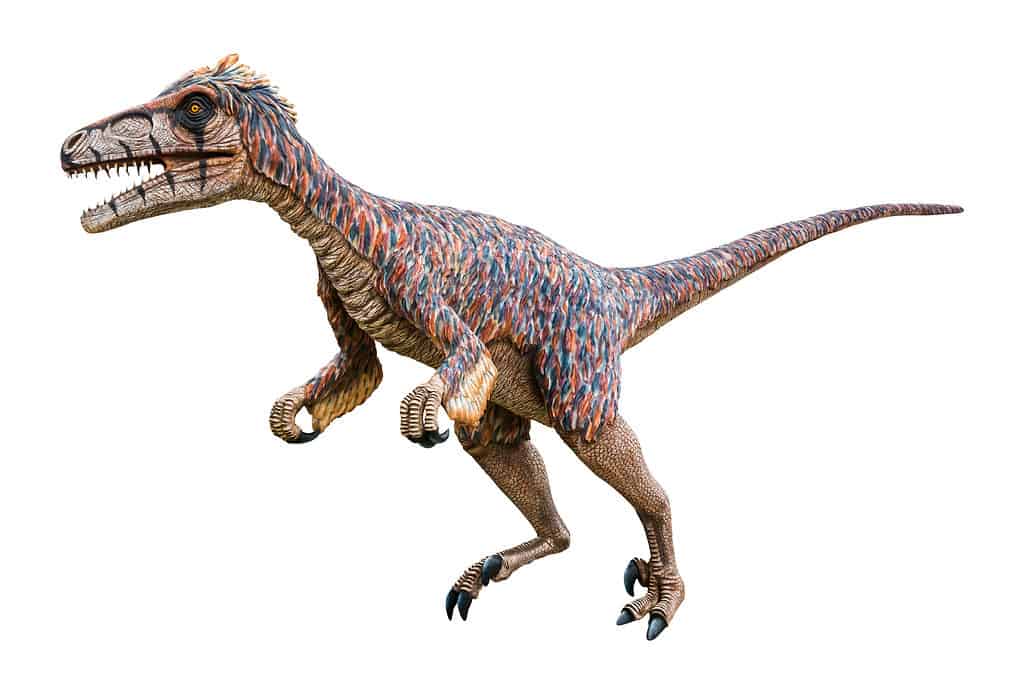
Dromaeosaurids were small or medium feathery theropods.
©YuRi Photolife/Shutterstock.com
4. Hadrosaurid
While the Parrosaurus missouriensis was clearly identified, remains of other unknown hadrosaurids were also found in Missouri. Given that the remains came from the same time as the Parrosaurus, the remains may have belonged to that species. They could have also been from any number of hadrosaurs that lived throughout this part of North America during that era.
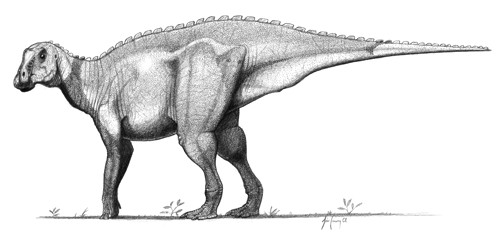
©John.Conway / CC BY-SA 3.0 – License
Where Can You See Fossils of Dinosaurs That Lived in Missouri?
Given that so few fossils exist from the state, it’s not likely that you’ll see actual fossils of dinosaurs that lived in Missouri at any of the museums in the state. Still, you can see fossils of other dinosaurs if you go to some facilities.
The Missouri Institute of Natural Science should be your first stop if you want to learn about dinosaurs that lived in Missouri. You can find this museum in Springfield, Missouri. The museum has fossils from Triceratops and many other specimens. The institute’s grounds have a place where you can actually look for fossils.
The Branson Dinosaur Museum is another place where you can see real fossils of dinosaurs along with reconstructions of dinosaurs, including the T-rex. As the museum’s name suggests, this facility is located in Branson, Missouri.
The Saint Genevieve Museum is another place where people can learn about dinosaurs that once lived in Missouri and beyond. Located in Genevieve, Missouri, this museum has places for learners of all ages and interests. Visitors will see life-sized recreations of dinosaurs, fossilized dinosaur eggs, and artifacts from foreign cultures.
Just make sure you take some time to look up each museum’s hours and days that they’re open. Even though you may not see the Parrosaurus in either museum, you can still learn a great deal about dinosaurs and the paleontology of Missouri.
Summary of 4 Dinosaurs That Lived in Missouri
Here’s a recap of the four dinosaurs we took a look at that once roamed Missouri.
| Number | Dinosaur | Group |
|---|---|---|
| 1 | Tyrannosaurid | Believed by some to belong to the Albertosaurus genus |
| 2 | Parrosaurus missouriensis | Classed as a hadrosaur |
| 3 | Dromaeosaurid | Unidentified member of the Dromaeosauridae family |
| 4 | Hadrosaurid | Classed as a hadrosaur |
The photo featured at the top of this post is © Daniel Eskridge/Shutterstock.com
Thank you for reading! Have some feedback for us? Contact the AZ Animals editorial team.



